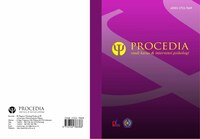Solution-Focused Therapy for improving spouse’s communication pattern
DOI:
https://doi.org/10.22219/procedia.v12i3.29909Keywords:
Family, indirrect communication, married couples, solution-focused therapyAbstract
Problems in the family, especially among married couples, are often caused by unhealthy communication patterns such as indirect communication. The aim of this research is to improve communication patterns between husband and wife to be more effective. The assessment was applied to the married couple using interviews, observation methods, and the Couple Communication Satisfaction Scale (CCSS). The results show that the husband and the wife had difficulties in expressing their aspirations and emotions. The husband is unable to communicate his loneliness after retirement. Moreover, he wants to spend time with his wife at home. On the other hand, the wife is busy with her work, she rarely pays attention to her husband at home. The intervention technique was 6 sessions of Solution-Focused Therapy (SFT) to improve the communication pattern between spouses. The results indicated that the therapy is an effective intervention to improve communication patterns. At the end of the intervention, the husband and wife can communicate directly and openly.
Permasalahan dalam keluarga, khususnya pada pasangan suami istri, sering kali disebabkan oleh pola komunikasi yang tidak sehat seperti komunikasi tidak langsung. Tujuan dari penelitian ini adalah untuk memperbaiki pola komunikasi suami istri agar lebih efektif. Asesmen dilakukan pada pasangan suami istri dengan menggunakan metode wawancara, observasi, dan Couple Communication Satisfaction Scale (CCSS). Hasil penelitian menunjukkan bahwa suami istri mengalami kesulitan dalam mengungkapkan aspirasi dan emosi. Suami tidak mampu mengomunikasikan rasa kesepiannya setelah pensiun. Selain itu, ia ingin menghabiskan waktu bersama istri di rumah. Di sisi lain, istri sibuk dengan pekerjaannya, ia jarang memperhatikan suaminya di rumah. Teknik intervensi yang dilakukan adalah Solution-Focused Therapy (SFT) sebanyak 6 sesi untuk memperbaiki pola komunikasi pasangan suami istri. Hasil penelitian menunjukkan bahwa terapi tersebut merupakan intervensi yang efektif untuk memperbaiki pola komunikasi. Di akhir intervensi, suami istri dapat berkomunikasi secara langsung dan terbuka.
Downloads
References
Agustin, I. (2016). Strategic family therapy untuk menangani masalah komunikasi ayah dan anak. Procedia: Studi Kasus Dan Intervensi Psikologi, 4(2), 63–67. https://doi.org/10.22219/procedia.v4i2.16238.
APA. (2022). Diagnostic and Statistical Manual of Mental Disorders: Fifth Edition Text Revision DSM-5-TRTM.
Ariani, A. (2021). Terapi keluarga untuk memperbaiki pola komunikasi orang tua dan anak. Procedia: Studi Kasus Dan Intervensi Psikologi, 8(4). https://doi.org/10.22219/procedia.v8i4.14787.
Cahyani, D. (2020). Solution focused therapy untuk memperbaiki pola komunikasi ibu dan anak. Procedia: Studi Kasus Dan Intervensi Psikologi, 7(2), 65–73. https://doi.org/10.22219/procedia.v7i2. 13024.
Canary, D. J., Stafford, L., & Semic, B. A. (2002). A panel study of the associations between maintenance strategies and relational characteristics. Journal of Marriage And Family, 64(2), 395-406. https://doi.org/10.1111/j.1741-3737.2002.00395.x.
Carr, A. (2006). Family Therapy: Concepts, Process, and Practice (Second Edition). John Wiley & Sons, Ltd. https://doi.org/10.1002/9780470713051.
Choi, J. J. (2020). A case study of solution-focused brief family therapy. American Journal of Family Therapy, 48(2), 195-210. https://doi.org/10.1080.01926187.2019.1691083.
Cox, E., Bachkirova, T., & Clutterbuck, D. (2010). The Complete Handbook of Coaching. SAGE Publications Ltd. https://doi.org/10.1080/14767333.2019.1655972.
Dai, L., & Wang, L. (2015). Review of family functioning. Open Journal of Social Sciences, 03(12), 134–141. https://doi.org/10.4236/jss.2015.312014.
Fajriyah, N. (2023). Meningkatkan pola komunikasi pada pasangan suami-istri. Procedia : Studi Kasus Dan Intervensi Psikologi, 11(2), 49–54. https://doi.org/10.22219/procedia.v11i2.24444.
Gleen, P. (2003). Laughter in Interaction. Cambridge University Press. https://doi.org/10.1017/CBO9780511519888.
Halford, W. K., Lee, S., Hiew, D. N., & van de Vijver, F. J. (2018). Indirect couple communication and relationship satisfaction in Chinese, Western, and Chinese-Western intercultural couples. Couple and Family Psychology: Research and Practice, 7(3-4), 183. https://doi.org/10.1037/cfp0000109.
Hartatik, Y. F. (2018). Solution focused therapy untuk memperbaiki komunikasi pada ayah dan anak. Procedia: Studi kasus dan Intervensi Psikologi, 6(1), 1-9. https://doi.org/10.22219/procedia.v6i1.12627.
Jones, A. C., Jones, R. L., & Morris, N. (2019). Development and validation of the couple communication satisfaction scale. The American Journal of Family Therapy, 46(5), 505-524. https://doi.org/10.1080/01926187.2019.1566874.
Kardinah, N. (2018). Keluarga dan problematikanya menuju keluarga sakinah (tinjauan dalam perspektif marital psikologi). Psympathic: Jurnal Ilmiah Psikologi, 1(1), 109–120. https://doi.org/10.15575/psy.v1i1.2171.
Kim, J., Jordan, S. S., Franklin, C., & Froerer, A. (2019). Is solution focused brief therapy evidence-based? An update 10 years later. Families in Society, 100(2), 127-138. https://doi.org/10.1177/1044389419841688.
Lebow, . L., Chambers, A. L., & Breulin, D. C. (2019). Encyclopedia of couple and family therapy. Springer International Publishing. https://doi.org/10.1007/978-3-319-15877-8.
Murray, C. E. (2006). Controversy, constraints, and context: understanding family violence through family system theory. The Family Journal: Counseling and Therapy for Couples and Families, 14(3), 234-239. https://doi.org/10.1177/1066480706287277.
Nelson, J. A., O’Brien, M., Grimm, K. J., & Leerkes, E. M. (2014). Identifying mother child interaction styles using a person centered approach. Social Development, 23(2), 306–324. https://doi.org/10.1111/sode.12040.
O’Connell, B. (1998). Solution-Focused Therapy. SAGE Publications Ltd. https://doi.org/10.1002/(SICI)1099-0879(199911).
Patterson, J., Williams, L., Edwards, T. M., Chamow, L., & GraufGrounds, C. (2018). Essential skills in family therapy: from the first interview to termination. Guilford Publications. https://doi.org/10.1080/07317107.2020.1780822.
Pirmoradi, S., Amini, N., Keykhosrovani, M., & Shafiabadi, A. (2022). Effectiveness of solution-focused brief therapy on marital commitment and marital burnout among couples with marital conflicts: A randomized trial. Journal of Midwifery and Reproductive Health, 1-8. https://doi.org/10.22038/jmrh.2022.65120.1899.
Poole, R. (1993). Kierkegaard: The indirect communication. University of Virginia Press. https://doi.org/10.1111/j.14682265.2009.00439.x.
Pratiwi, N. S. (2022). Behavioral couples therapy untuk memperbaiki pola komunikasi pada pasangan suami istri. Procedia: Studi Kasus Dan Intervensi Psikologi, 10(2), 58–63. https://doi.org/10.22219/procedia.v10i2.19000.
Putri, D. P. K., & Lestari, S. (2016). Pembagian peran dalam rumah tangga pada pasangan suami istri Jawa. Jurnal Penelitian Humaniora, 16(1), 72-85. https://doi.org/10.23917/humaniora.v16i1.1523.
Rahmah, H. (2020). Solution focused therapy untuk memperbaiki komunikasi pada pasangan suami dan istri. Al-Falah: Jurnal Ilmiah Keislaman dan Kemasyarakatan, 20(2), 117-132. https://doi.org/ 10.47732/alfalahjikk.v20i2.143.
Safira, T. (2020). Solution focused therapy untuk memperbaiki pola komunikasi keluarga. Procedia: Studi Kasus Dan Intervensi Psikologi, 8(1), 1-8. https://doi.org/10.22219/procedia.v4i1.11965.
Downloads
Published
How to Cite
Issue
Section
License
Copyright (c) 2024 Firgineta Salsabela Ramadhana, Ratih Eka Pertiwi, Cahyaning Suryaningrum

This work is licensed under a Creative Commons Attribution-NonCommercial 4.0 International License.






